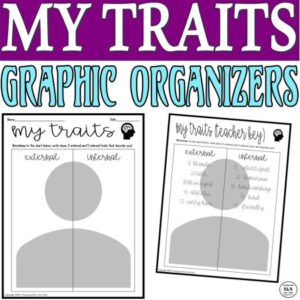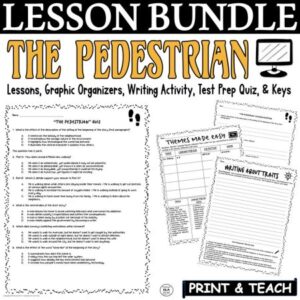If you have not read The Pedestrian by Ray Bradbury, get ready to enjoy a fantastic short story! Ray Bradbury’s dystopian story set in 2131 begins with a description of a man who walks through the city while everyone else watches their television screens. This situation seems like a simple premise, but when the man encounters the police and declares that he is a writer, the values of society are revealed!
The Pedestrian by Ray Bradbury is SUPER short, but it will have a BIG impact on your students!
Keep reading below for 7 Ways to Teach The Pedestrian by Ray Bradbury!
Need help with Test Prep? Check out this FREE Pack of 3 Test Prep Activities to help students achieve success on standardized tests!

7 Ways to Teach The Pedestrian by Ray Bradbury
1. Teach Vocabulary
Ray Bradbury uses diverse vocabulary, yet most of his writing is not really that difficult to read…at least language-wise. Many of our struggling readers, however, may need help with learning this vocabulary. And that’s okay. Meeting our students where they are is vital to student growth.
Here are some words that you might want to focus on before you read The Pedestrian by Ray Bradbury:
- buckling
- faintest
- peer
- phantoms
- manifest
- murmurs
- intermittent
- infrequent
- ceaseless
- radiance
- ebbing
- specimen
- phonograph
- antiseptic
- illumination
Before reading, students could pick words they don’t know to research, illustrate, and analyze OR you could assign specific words to small groups, pairs, or individual students!
If you need more ideas for teaching short stories, click below!
2. Teach Theme
What is a Theme?
Theme is simply the message or messages the author desires to convey. Keep in mind that this message (theme) should go beyond one or two words. We don’t want a phrase. We want to see an entire sentence when teaching about theme!
There could also be multiple themes in a short story, and really there is no perfectly crafted theme. Well, this statement is true unless the author tells us otherwise…
HOW TO DETERMINE THEME:
- Determine the major topics in The Pedestrian by Ray Bradbury. (ex. technology, society, literacy, etc.)
- Identify what the author is trying to say about the topic.
- Write a theme in 1 sentence.
Sounds super simple, but I know the process of teaching theme is tough.
Check out this THEMES MADE EASY pack to help with the process of teaching theme!
3. Teach Characterization
Characterization refers to how a character is described or depicted. We can discern characterization through the narrative description, dialogue, and the character’s actions/interactions.
There are 2 types of characterization-
- Direct Characterization-We as readers are DIRECTLY told about a character’s traits.
- Indirect Characterization-Readers need to infer a character’s traits based on INDIRECT means.
For example, at the beginning of The Pedestrian by Ray Bradbury, we are DIRECTLY told that Leonard Mead loves to walk. It is not a mystery; we don’t have to infer anything.
In contrast to Leonard, we can read about the other people in the city. He “talks” to them and through this “discussion,” we can infer that they are superficial and blinded by technology.
You could also focus on INTERNAL and EXTERNAL character traits. Check out this FREE PACK to make introducing characterization a bit easier!
4. Teach Mood
Mood is the emotion intended to be created through the setting and/or actions of the characters. Identifying the mood can be tough to teach though. When it comes to watching movies, the mood is much easier to analyze.
Through the visuals and sounds/music, the viewer can quickly recognize the intended mood or shift in mood.
At the beginning of The Pedestrian by Ray Bradbury, the setting depicts a “misty evening” as Leonard walks in relative silence. There is no ominous mood yet, nothing to really indicate what will happen at the end of the story. If anything, the mood is neutral and unassuming.
By the end of the story, the mood has changed quite drastically. With the simple repetitive command “Get in,” we experience a sense of fear and trepidation for Leonard. The inside of the vehicle is hard and unnatural compared to the natural setting of the outdoors.
The menacing mood plays an important role as we ultimately begin to understand Leonard Mead’s fate.
5. Teach Paragraph Writing
Ultimately, I am a huge believer that students need tons of writing practice to become successful writers. Go figure, right?
Well, this structure is my go-to for paragraph responses:
- Answer the question being asked.
- Incorporate a piece of evidence from the text that helps to support the answer.
- Explain the meaning of the evidence and discuss how the evidence conveys a specific meaning/message.
- Transition to another piece of evidence from the text that helps to support the answer.
- Explain the meaning of the evidence and discuss how the evidence conveys a specific meaning/message.
- Reiterate the answer and reinforce how the evidence contributes to the meaning/theme of the text.
SAMPLE WRITING PROMPTS:
- How is Leonard different from others around him in the story “The Pedestrian?”
- How do the differences between Leonard and others in society contribute to the theme of the story?
- What is the mood in The Pedestrian by Ray Bradbury?
- How does the mood change in the story?
- What is the setting of The Pedestrian by Ray Bradbury and how does it play a role in the story?
Click below for ready-to-use activities to make teaching The Pedestrian by Ray Bradbury STRESS-FREE!
6. Teach Literary Devices
There are so many ways we can attack the literary devices with this story!
My favorite literary devices to examine in The Pedestrian by Ray Bradbury are the following:
- irony
- imagery
- metaphor
- simile
- personification
- repetition
Process for teaching literary devices:
- Define the terms.
- Provide examples.
- Help students identify devices in the story.
- Practice analyzing HOW the device is being used in 2-3 sentences.
- After reading the story, maybe students could create their own examples in a sentence for each or within a paragraph…
Overall, the inclusion of literary devices is not arbitrary. The author always has a purpose in using specific elements to convey meaning. When students understand this concept, they will begin to see these devices EVERYWHERE!
7. Teach Dystopian Elements
Unlike a utopia (a perfect society), a dystopia is a seemingly perfect society undergirded by immense societal or governmental issues.
There are so many books, short stories, movies, and television shows that incorporate a dystopic world. You may have heard of The Giver, “The Veldt,” The Hunger Games, The Handmaid’s Tale, and, of course, “The Pedestrian.”
Usually, dystopian worlds are extremely futuristic and/or extremely naturalistic in some way. Likewise, there is an unjust contrast between people groups, minorities, majorities, or individuals.
And more than anything, there is a struggle for control over one’s life choices.
In The Pedestrian by Ray Bradbury, we have the government asserting control over the people through technology. The odd, divergent members of this world, like Leonard Mead, refuse to be placated by television screens. Instead, he writes and walks, quite normal activities by today’s standards. Yet in this world, these independent and thoughtful activities stand in direct opposition to the governmental institutions.
In teaching these typical dystopian elements, I would encourage students to end with a discussion involving this short story.
These questions might help facilitate discussion in a Socratic Seminar:
- How is the government portrayed?
- What are the various settings of the story?
- What is the role of the car?
- How is Leonard Mead different from others in this story?
- How does technology play a role in the story?
- What other stories, movies, books, and television shows mirror ideas in this story?
- In what ways is the society from The Pedestrian by Ray Bradbury similar to society today?
By posing and discussing such questions, we get students thinking, connecting, and analyzing beyond the text! That is definitely the ultimate goal!
Check out this BUNDLE below for print and teach activities for The Pedestrian by Ray Bradbury!
Need more help with teaching The Pedestrian by Ray Bradbury? Check out my store Kristin Menke-Integrated ELA Test Prep!








